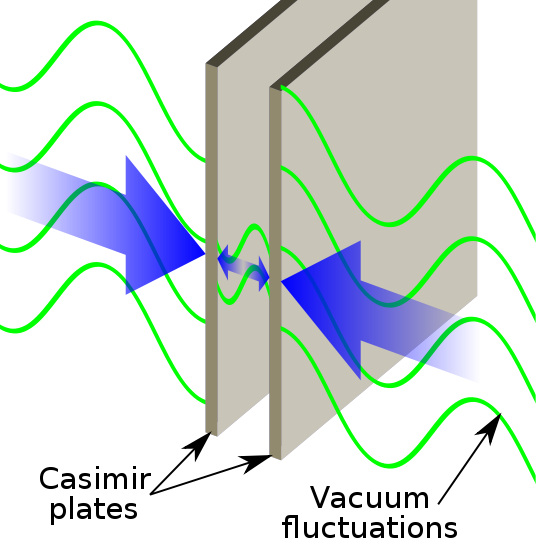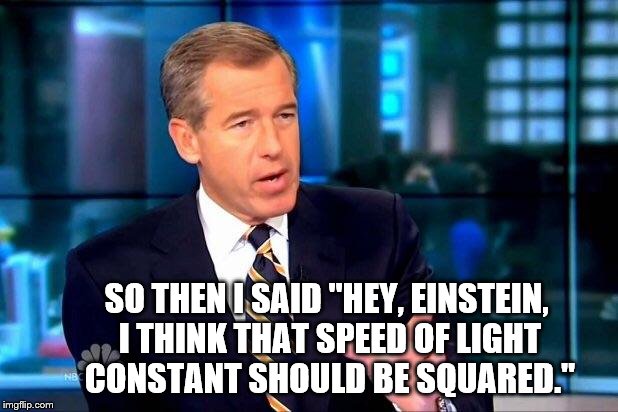Skip to comments.
The force of the vacuum
Phys.org ^
| Dec 3, 2018
| Jenny Witt, Max Planck Institute for the Structure and Dynamics of Matter
Posted on 12/03/2018 9:56:47 AM PST by ETL
Scientists from the Theory Department of the Max Planck Institute for the Structure and Dynamics of Matter (MPSD) at the Center for Free-Electron Laser Science (CFEL) in Hamburg, Germany have shown through theoretical calculations and computer simulations that the force between electrons and lattice distortions in an atomically thin two-dimensional superconductor can be controlled with virtual photons. This could aid the development of new superconductors for energy-saving devices and many other technical applications.
The vacuum is not empty. It may sound like magic to laypeople but the problem has preoccupied physicists since the birth of quantum mechanics. The apparent void bubbles incessantly and produces fluctuations of light even at absolute zero temperature. In a sense, these virtual photons are just waiting to be used. They can carry forces and change the properties of matter.
The force of the vacuum, for instance, is known to produce the Casimir effect. When one moves two parallel metallic plates of a capacitor very close together, they feel a microscopically small but measurable attraction between each other, even if the plates are not electrically charged. This attraction is created by the exchange of virtual photons between the plates, like two ice skaters who throw a ball back and forth and are subjected to the recoil. If the ball was invisible, one would assume that a repellent force acts between them.
Now, the MPSD team of Michael Sentef, Michael Ruggenthaler and Angel Rubio has published a study in Science Advances, which draws a connection between the force of the vacuum and the most modern materials. In particular, they explore the question of what happens if the two-dimensional high-temperature superconductor iron selenide (FeSe) on a substrate of SrTiO3 is located in the gap between two metallic plates where virtual photons fly back and forth.
The outcome of their theories and simulations: the force of the vacuum makes it possible to couple the fast electrons in the 2-D layer more strongly to the lattice vibrations of the substrate, which swing perpendicular to the 2-D layer. The coupling of superconducting electrons and the vibrations of the crystal lattice is a central building block for important properties of many materials.
"We are only beginning to understand these processes," says Michael Sentef. "For example, we do not know precisely how strong the influence of the vacuum light would realistically be on the oscillations of the surface. We are talking about quasiparticles of light and phonons, so-called phonon polaritons." In 3-D insulators, phonon polaritons were measured with lasers decades ago. However, this is new scientific territory where complex new 2-D quantum materials are concerned. "Of course we hope that our work prompts the experimental colleagues to test our predictions," Sentef adds.
MPSD Theory Director Angel Rubio is delighted about those new possibilities: "The theories and numerical simulations in our department are a key element in a whole new generation of potential technological developments. Even more importantly, it will encourage researchers to reconsider the old problems associated with the interaction between light and the structure of matter."
Rubio is highly optimistic regarding the role of fundamental research in this area. "Together with the experimental progress, for example in the controlled production and precise measurement of atomic structures and their electronic properties, we can look forward to great discoveries." In his view, scientists are about to embark on a new era of the atomic design of the functionalities in chemical compounds, particularly in 2-D materials and complex molecules. Rubio is convinced: "The force of the vacuum will help us in this quest."

Explore further: Shedding light on Weyl fermions
More information: M. A. Sentef et al. Cavity quantum-electrodynamical polaritonically enhanced electron-phonon coupling and its influence on superconductivity, Science Advances (2018). DOI: 10.1126/sciadv.aau6969
Journal reference: Science Advances
Provided by: Max Planck Institute for the Structure and Dynamics of Matter
TOPICS: Chit/Chat; Science; Weird Stuff
KEYWORDS: angelrubio; casimireffect; electrogravitics; electromagneticdrive; emdrive; fese; ironselenide; mdrive; michaelruggenthaler; michaelsentef; mpsd; newtonsthirdlaw; propellentlessdrive; quantummechanics; rogershawyer; srtio3; stringtheory; strontiumtitanate; virtualphotons
"The vacuum is not empty. It may sound like magic to laypeople but the problem has preoccupied physicists since the birth of quantum mechanics. The apparent void bubbles incessantly and produces fluctuations of light even at absolute zero temperature. In a sense, these virtual photons are just waiting to be used. They can carry forces and change the properties of matter. The force of the vacuum, for instance, is known to produce the Casimir effect."
__________________________________________________
What is the Casimir effect?
To understand the Casimir Effect, one first has to understand something about a vacuum in space as it is viewed in quantum field theory.
Far from being empty, modern physics assumes that a vacuum is full of fluctuating electromagnetic waves that can never be completely eliminated, like an ocean with waves that are always present and can never be stopped.
These waves come in all possible wavelengths, and their presence implies that empty space contains a certain amount of energy—an energy that we can’t tap, but that is always there.
Now, if mirrors are placed facing each other in a vacuum, some of the waves will fit between them, bouncing back and forth, while others will not.
As the two mirrors move closer to each other, the longer waves will no longer fit—the result being that the total amount of energy in the vacuum between the plates will be a bit less than the amount elsewhere in the vacuum.
Thus, the mirrors will attract each other, just as two objects held together by a stretched spring will move together as the energy stored in the spring decreases.
This effect, that two mirrors in a vacuum will be attracted to each other, is the Casimir Effect.

It was first predicted in 1948 by Dutch physicist Hendrick Casimir. Steve K. Lamoreaux, now at Los Alamos National Laboratory, initially measured the tiny force in 1996.
It is generally true that the amount of energy in a piece of vacuum can be altered by material around it, and the term “Casimir Effect” is also used in this broader context.
If the mirrors move rapidly, some of the vacuum waves can become real waves. Julian Schwinger and many others have suggested that this “dynamical Casimir effect” may be responsible for the mysterious phenomenon known as sonoluminescence.
One of the most interesting aspects of vacuum energy (with or without mirrors) is that, calculated in quantum field theory, it is infinite! To some, this finding implies that the vacuum of space could be an enormous source of energy—called “zero point energy.”
But the finding also raises a physical problem: there’s nothing to stop arbitrarily small waves from fitting between two mirrors, and there is an infinite number of these wavelengths.
The mathematical solution is to temporarily do the calculation for a finite number of waves for two different separations of the mirrors, find the associated difference in vacuum energies and then argue that the difference remains finite as one allows the number of wavelengths to go to infinity.
Although this trick works, and gives answers in agreement with experiment, the problem of an infinite vacuum energy is a serious one.
Einstein’s theory of gravitation implies that this energy must produce an infinite gravitational curvature of spacetime—something we most definitely do not observe.
The resolution of this problem is still an open research question.
https://www.scientificamerican.com/article/what-is-the-casimir-effec/
1
posted on
12/03/2018 9:56:47 AM PST
by
ETL
To: ETL
😴😴😴
2
posted on
12/03/2018 10:01:25 AM PST
by
GoldenPup
To: ETL
The article was refereed by Alexandria Ocasio-Cortez.
3
posted on
12/03/2018 10:01:48 AM PST
by
bwest
To: ETL
4
posted on
12/03/2018 10:02:13 AM PST
by
Red Badger
(We are headed for a Civil War. It won't be nice like the last one....................)
To: bwest
“the force between electrons and lattice distortions in an atomically thin two-dimensional superconductor can be controlled with virtual photons. This could aid the development of new superconductors for energy-saving devices and many other technical applications.”
Oh, got it. NOW I understand.
5
posted on
12/03/2018 10:03:37 AM PST
by
V_TWIN
To: GoldenPup

zzzzzzzzzz.....
6
posted on
12/03/2018 10:06:14 AM PST
by
ETL
(Obama-Hillary, REAL Russia collusion! Uranium-One Deal, Missile Defense, Iran Deal, Nukes: Click ETL)
To: V_TWIN
It's always nice when things are explained so clearly. / sarc
"Virtual" photons?
7
posted on
12/03/2018 10:06:28 AM PST
by
Pecos
(Better the one you have with you than the one you left at home.)
To: ETL
8
posted on
12/03/2018 10:11:09 AM PST
by
Fiddlstix
(Warning! This Is A Subliminal Tagline! Read it at your own risk!(Presented by TagLines R US))
To: bwest
> The article was refereed by Alexandria Ocasio-Cortez. <
Yes. But Brian Williams thought of it first.

9
posted on
12/03/2018 10:12:03 AM PST
by
Leaning Right
(I have already previewed or do not wish to preview this composition.)
To: Leaning Right
10
posted on
12/03/2018 10:15:25 AM PST
by
timestax
To: All
Ultra-cold mirrors could reveal gravity’s quantum side
By Adam Becker
An experiment not much bigger than a tabletop, using ultra-cold metal plates, could serve up a cosmic feast. It could give us a glimpse of quantum gravity and so lead to a “theory of everything“: one that unites the laws of quantum mechanics, governing the very small, and those of general relativity, concerning the monstrously huge.
Such theories are difficult to test in the lab because they probe such extreme scales. But quantum effects have a way of showing up unexpectedly. In a strange quantum phenomenon known as the Casimir effect, two sheets of metal held very close together in a vacuum will attract each other.
The effect occurs because, even in empty space, there is an electromagnetic field that fluctuates slightly all the time. Placing two metal sheets very close to one another limits the fluctuations between them, because the sheets reflect electromagnetic waves. But elsewhere the fluctuations are unrestricted, and this pushes the plates together.
James Quach at the University of Tokyo suggests that we might be able to observe the equivalent effect for gravity. That would, in turn, be direct evidence of the quantum nature of gravity: the Casimir effect depends on vacuum fluctuations, which are only predicted by quantum physics.
But in order to detect it, you would need something that reflects gravitational waves – the ripples in space-time predicted by general relativity. Earlier research suggested that superconductors (for example, metals cooled to close to absolute zero such that they lose all electrical resistance) might act as mirrors in this way.
“The quantum properties of superconductors may reflect gravitational waves. If this is correct, then the gravitational Casimir effect for superconductors should be large,” says Quach. “The experiment I propose is feasible with current technology.”
It’s still unclear if superconductors actually reflect gravitational waves, however. “The exciting part of this paper has to do with a speculative idea about gravitational waves and superconductors,” says Dimitra Karabali at Lehman College in New York. “But if it’s right, it’s wonderful.”
Journal reference: Physical Review Letters, DOI: 10.1103/PhysRevLett.114.081104
source:
https://www.newscientist.com/article/dn27060-ultra-cold-mirrors-could-reveal-gravitys-quantum-side/
11
posted on
12/03/2018 10:18:46 AM PST
by
ETL
(Obama-Hillary, REAL Russia collusion! Uranium-One Deal, Missile Defense, Iran Deal, Nukes: Click ETL)
To: timestax
12
posted on
12/03/2018 10:19:46 AM PST
by
timestax
To: SunkenCiv
13
posted on
12/03/2018 10:38:29 AM PST
by
fieldmarshaldj
("It's Slappin' Time !")
To: All
According to Einstein’s General Relativity, massive objects “curve” or “warp” space to create the phenomenon we know as gravity. But we were always taught that space is empty (a vacuum). So how can something that is ‘empty’ curve or warp? As it turns out, space isn’t really empty. This is basically what this article and the other pieces I posted are based on.
14
posted on
12/03/2018 10:44:07 AM PST
by
ETL
(Obama-Hillary, REAL Russia collusion! Uranium-One Deal, Missile Defense, Iran Deal, Nukes: Click ETL)
To: All
“Isaac Newton described the effects of gravity, but didn’t propose a mechanism for how it worked
Albert Einstein proposed that massive objects warp and curve the universe, resulting in other objects moving on or orbiting along those curves—and that this is what we experience as gravity”
https://www.science.org.au/curious/space-time/gravity
15
posted on
12/03/2018 10:44:17 AM PST
by
ETL
(Obama-Hillary, REAL Russia collusion! Uranium-One Deal, Missile Defense, Iran Deal, Nukes: Click ETL)
To: Fiddlstix
Interesting. But one wouldn’t expect that “empty” space behave in the same way as air, with pressure differences, etc.
16
posted on
12/03/2018 10:48:43 AM PST
by
ETL
(Obama-Hillary, REAL Russia collusion! Uranium-One Deal, Missile Defense, Iran Deal, Nukes: Click ETL)
To: ETL
Cute doggie. No stranger to the dinner bowl.
To: GoldenPup
Wasn’t Max Plank a billionaire lumber magnate?
18
posted on
12/03/2018 12:01:39 PM PST
by
SgtHooper
(If you remember the 60's, YOU WEREN'T THERE!)
To: fieldmarshaldj; 6SJ7; AdmSmith; AFPhys; Arkinsaw; allmost; aristotleman; autumnraine; bajabaja; ...
19
posted on
12/03/2018 4:26:38 PM PST
by
SunkenCiv
(and btw -- https://www.gofundme.com/for-rotator-cuff-repair-surgery)
20
posted on
12/03/2018 4:39:23 PM PST
by
SunkenCiv
(and btw -- https://www.gofundme.com/for-rotator-cuff-repair-surgery)
Disclaimer:
Opinions posted on Free Republic are those of the individual
posters and do not necessarily represent the opinion of Free Republic or its
management. All materials posted herein are protected by copyright law and the
exemption for fair use of copyrighted works.
FreeRepublic.com is powered by software copyright 2000-2008 John Robinson







